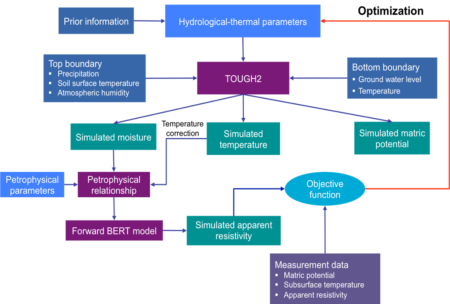
Flowchart showing the steps involved in the coupled hydrological-thermal-geophysical inversion scheme. Data for inversion in this study include matric potential, subsurface temperature and apparent resistivity
Scientific Achievement
The approach developed in this study is expected to be especially useful for an increasing number of studies that are taking advantage of autonomously collected soil electrical resistivity, moisture and temperature data to explore complex terrestrial system dynamics
Significance and Impact
The inversion scheme provides the desired subsurface property estimates in high spatiotemporal resolution. A particularly novel aspect of the inversion scheme is the explicit incorporation of the dependence of the subsurface electrical resistivity on both moisture and temperature.
Research Details
- Consider the non-isothermal behaviour of the shallow subsurface as well as multiphase of moisture
- Show that water infiltration in the top 50 cm does not occur every year due to high evaporation rate
- Demonstrate the importance of considering subsurface temperature variability and its direct and indirect influence on the electrical resistivity
Citation
Tran, A. P.; Dafflon, B.; Hubbard, S. S.; Kowalsky, M. B.; Long, P.; Tokunaga, T. K.; Williams, K. H. (2016), Quantifying shallow subsurface water and heat dynamics using coupled hydrological-thermal-geophysical inversion, Hydrology and Earth System Sciences, 20(8), 3477-3491, DOI: 10.5194/hess-20-3477-2016.
